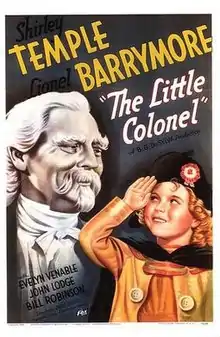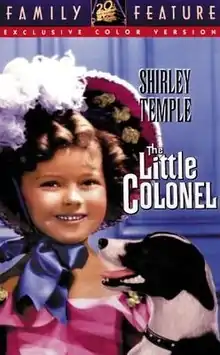The Little Colonel (1935 film)
The Little Colonel is a 1935 American comedy drama film directed by David Butler. The screenplay by William M. Conselman was adapted from the children's novel of the same name by Annie Fellows Johnston, originally published in 1895. It focuses on the reconciliation of an estranged father and daughter in the years following the American Civil War. The film stars Shirley Temple, Lionel Barrymore, Evelyn Venable, John Lodge, Bill Robinson, and Hattie McDaniel.
| The Little Colonel | |
|---|---|
 Theatrical release poster | |
| Directed by | David Butler |
| Produced by | Buddy G. DeSylva |
| Written by | Screenplay: William M. Conselman Novel: Annie Fellows Johnston |
| Starring | Shirley Temple Lionel Barrymore Evelyn Venable John Lodge Bill Robinson Hattie McDaniel |
| Music by | Cyril J. Mockridge |
| Cinematography | Arthur C. Miller |
Production company | |
| Distributed by | Fox Film |
Release date |
|
Running time | 80 minutes |
| Country | United States |
| Language | English |
| Box office | $1.2 million[1] |
The Little Colonel was the first of four cinematic pairings between Temple and Robinson, and features the duo's famous staircase tap dance. The film was well received, and, in 1994, was available on videocassette in both black-and-white and computer-colorized versions.
Plot
Shortly after the American Civil War, southern belle Elizabeth Lloyd (Evelyn Venable) marries a northerner, Jack Sherman (John Lodge). Her father Colonel Lloyd (Lionel Barrymore) disowns her in anger and retaliation. Elizabeth and Jack move west where they become parents of a girl they name Lloyd Sherman (Shirley Temple).
Six years later, Lloyd Sherman is made an honorary colonel in the Army. Elizabeth returns to the south with little Lloyd and settles in a cottage near Colonel Lloyd’s mansion while her husband Jack remains in the west prospecting for gold. When Colonel Lloyd discovers his daughter living in the neighborhood, he treats her with disdain. Little Lloyd learns of her parents’ past from housekeeper Mom Beck (Hattie McDaniel), and, when she meets her grandfather for the first time, throws mud at him. The two eventually become contentious friends.
Elizabeth’s husband returns from the west with a fever. He has lost everything in his prospecting venture, but the family is saved from complete ruin when the Union Pacific Railroad requests right of way across Jack’s western property. Jack's former prospecting partners have heard of the Railroad’s offer and try to swindle Jack. They resort to holding the Sherman couple hostage until the deed to their valuable property is located.
Little Lloyd runs through the dark woods for her grandfather, but he refuses to help. He changes his mind when little Lloyd says she never wants to see him again. They arrive at the cottage just in time to save Elizabeth and Jack. The film ends with a brief Technicolor sequence featuring a 'pink party' for little Lloyd, her friends, and her reconciled family.
Cast
- Shirley Temple as Lloyd Sherman
- Lionel Barrymore as Colonel Lloyd
- Evelyn Venable as Elizabeth Lloyd Sherman
- John Lodge as Jack Sherman
- Sidney Blackmer as Swazey
- Stephen Chase as Hull
- William Burress as Dr. Scott
- Frank Darien as Nebler
- Bill Robinson as Walker
- Robert Warwick as Colonel Gray
- Hattie McDaniel as Becky 'Mom Beck' Porter
- Geneva Williams as Maria
- Avonnie Jackson as May Lily
- Nyanza Potts as Henry Clay
Production
.jpg.webp)
.jpg.webp)
The Little Colonel is best known for the famous staircase tap dance between Robinson and Temple. It was the first interracial dance pairing in Hollywood history and was so controversial that it was cut out in the Southern United States. The idea was actually first proposed by Fox head Winfield Sheehan after a discussion with D. W. Griffith. Sheehan set his sights on Robinson, but unsure of his ability as an actor, arranged for a contract that would be voided if Robinson failed the dramatic test. Robinson passed the test and was brought in to both star with Temple and to teach her tap dancing.[2] They quickly hit it off, as Temple recounted years later:
Robinson walked a step ahead of us, but when he noticed me hurrying to catch up, he shortened his stride to accommodate mine. I kept reaching up for his hand, but he hadn't looked down and seemed unaware. Fannie called his attention to what I was doing, so he stopped short, bent low over me, his eyes wide and rows of brilliant teeth showing in a wide smile. When he took my hand in his, it felt large and cool. For a few moments, we continued walking in silence. "Can I call you Uncle Billy?" I asked. "Why sure you can," he replied... "But then I get to call you darlin′." It was a deal. From then on, whenever we walked together it was hand in hand, and I was always his "darlin′."[3]
During the filming, Temple drew the ire of veteran actor Lionel Barrymore when she prompted him for one of his lines after he forgot it, causing him to storm off in a fit of anger. Temple was sent off to apologize to Barrymore, but, instead of directly apologizing, told him she thought he was the best actor in the world and asked for his autograph, defusing the situation and bringing Barrymore onto the set.[4]
This film made brief usage of early Technicolor film, which required heavy usage of red-hued makeup for the actors. It would be the only time that Temple would wear makeup on the set of her Fox films.[5]
Release
Distribution
When screened for audiences in Southern states, to ensure the film's widest distribution, Fox removed the staircase scene where Temple and Robinson touch hands.[6]
Critical responses

Andre Sennwald in his New York Times review of March 22, 1935, thought the film "[a]ll adrip with magnolia whimsy and vast, unashamed portions of synthetic Dixie atmosphere". He further wrote that the film was "so ruthless in its exploitation of Miss Temple's great talent for infant charm that it seldom succeeds in being properly lively and gay". He finished his review noting the audience applauded for a full eleven seconds after the final fade-out, and that the film "ought to bring out the best in every one who sees it."[7]
Home media
In 2009, the film was available on videocassette and DVD in both the original black-and-white version and a computer-colorized version of the original. Some versions included theatrical trailers and other special features.
References
- Footnotes
- Aubrey Solomon, Twentieth Century-Fox: A Corporate and Financial History Rowman & Littlefield, 2002 p 217
- Shirley Temple Black, Child Star: An Autobiography (New York: McGraw-Hill Publishing Company, 1988), 90-91.
- Shirley Temple Black, Child Star: An Autobiography (New York: McGraw-Hill Publishing Company, 1988), 91.
- Shirley Temple Black, Child Star: An Autobiography (New York: McGraw-Hill Publishing Company, 1988), 93-94.
- Shirley Temple Black, Child Star: An Autobiography (New York: McGraw-Hill Publishing Company, 1988), 97.
- Osterweil, Ara (2009). "Reconstructing Shirley: Pedophilia and Interracial Romance in Hollywood's Age of Innocence". Camera Obscura. Duke University Press. 24 (3): 14. doi:10.1215/02705346-2009-008. Retrieved 2020-03-22.
- Sennwald, Andre (March 22, 1935). "Shirley Temple and Lionel Barrymore in 'The Little Colonel,' the New Film at the Music Hall". The New York Times. Retrieved 2009-10-08.
- Works cited
- Windeler, Robert (1992) [1978], The Films of Shirley Temple, New York: Carol Publishing Group, ISBN 0-8065-0725-X
- Bibliography
- Thomson, Rosemarie Garland, ed. (1996), Freakery: Cultural Spectacles of the Extraordinary Body, New York: New York University Press, pp. 185–203, ISBN 0-8147-8217-5 In her essay "Cuteness and Commodity Aesthetics: Tom Thumb and Shirley Temple", Lori Merish examines 'the cult of cuteness' in America.
External links
- The Little Colonel at the American Film Institute Catalog
- Annie Fellows Johnston and the Little Colonel
- Kate Matthews Collection (includes illustrations for The Little Colonel books by Johnston's friend and neighbor, photographer Kate Matthews)
- The Little Colonel at IMDb
- The Little Colonel at the TCM Movie Database
- The Little Colonel at AllMovie